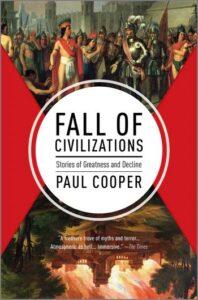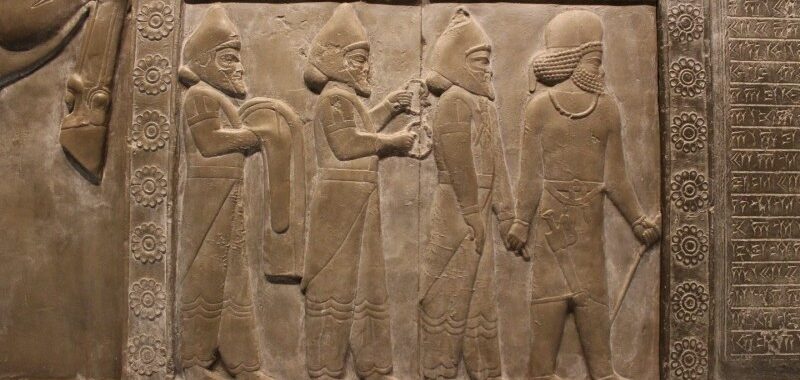One Sumerian epic poem called Enmerkar and the Lord of Aratta gives the first known story about the invention of writing, by a king who has to send so many messages that his messenger can’t remember them all.
Article continues below
His speech was substantial, and its contents extensive… Because the messenger, whose mouth was tired, was not able to repeat it, the lord of Kulaba patted some clay and wrote the message as if on a tablet. Formerly, the writing of messages on clay was not established. Now, under that sun and on that day, it was indeed so.
The Sumerians had two things in virtually limitless abundance: the clay beneath their feet, and the reeds that grew on the marshes and riverbanks—and these combined to create the written word. They made marks on palm-sized tablets of wet clay with the ends of cut reeds, and the distinctive shape of these impressions gives this form of writing its name, from the Latin for “wedge-shaped”: cuneiform. The oldest cuneiform clay tablets come from the Sumerian city of Uruk, and date to the late fourth millennium BCE. They are ergonomically shaped to the human and, and as a result are roughly the dimensions of a modern smartphone.
Cuneiform was at first made up of some 1,500 pictograms that each represented a whole word—but scribes had to work fast, copying hundreds of documents throughout their day. Over time, the original pictographs naturally became simpler and more abstract. Around this time, someone had the bright idea that each symbol could also stand for a certain sound, instead of a whole idea, and after 3000 BCE, this meant number of symbols was reduced from some 1,500 to about 600. These were the beginnings of the first alphabets. The human brain would never be the same again—and in large part thanks to this new ability to record and pass on knowledge, the technology of Sumer made even greater leaps forward.
The human brain would never be the same again—and in large part thanks to this new ability to record and pass on knowledge.
This phase of Mesopotamian history is known as the Uruk Period, which lasted until the end of the fourth millennium BCE. One of the key markers of the shift into this period is a dramatic change in the region’s pottery—but it did not become more sophisticated and ornate as technology improved. In fact, the pottery of the preceding Ubaid Period was exceptionally beautiful, made on a device known as a slow wheel and painted with distinctive geometrical designs in brown or black glaze. These were luxury items for the wealthy few. The Uruk Period, by contrast, saw a significant increase in the amount of pottery produced—but the quality fell dramatically. Thanks to the new ‘fast wheel’, clay jars and pots could be made in great numbers by workmen in intensive workshops, and they could now be afforded by everyone. This was the first era of mass production.
In their clay documents, the buzzing economy of the Sumerian cities comes to life in a slew of numbers. We know that in Girsu, for instance, 15,000 women were employed in the textile industry. One factory produced 1,100 tons of flour a year, but also bread, beer and linseed oil, as well as grindstones, woven reeds and clay pots. This factory employed 134 specialists, and 858 skilled workers, of which 669 were women, 86 were men, and 103 were teenagers of both genders. Since there was no currency at this time, workers were paid directly in food and other goods. The minimum ration of an unskilled factory worker consisted of twenty liters of barley a month, along with two liters of oil and two kilos of wool per year, while their supervisor might earn twice this ration. Poorer workers sometimes had to supplement their income by borrowing commodities—like silver, grain or wool—from lenders, always at crushing interest rates.
Of all the Sumerian settlements, the one that would rise to the greatest heights was the one that gave the period its name: Uruk. By the end of the fourth millennium BCE—when the earliest of the Egyptian pyramids was still at least 400 years in the future, and the large stones at Stonehenge would not be laid for another 800 years—the city of Uruk and its surrounding metropolitan area had swelled to some 90,000 inhabitants and covered two and a half square kilometers. It was the largest settlement the world had yet seen.
Humanity’s earliest surviving work of literature, the Epic of Gilgamesh, begins in Uruk. The real King Gilgamesh probably ruled over the city in the early third millennium BCE, and made enough of an impression that he went down in legend as a mythical hero, two-thirds god and one-third man. Over the centuries that followed, his stories were likely passed by word of mouth, before being set down on clay by later Babylonian and Assyrian scribes. Although it contains far more myth than historical fact, the Epic of Gilgamesh does tell us about how Sumerian society was changing. For one thing, it’s evident that warfare had begun to increase. As the tale opens, one feature of the city is repeatedly mentioned as a source of pride: a ring of enormous, fortified walls.
Ascend and walk about on the wall of Uruk,
Inspect the corner-stone, and examine its brick-work,
Are its walls not made of burned brick, and its foundation overlaid with pitch?
We can surmise that city walls were by now necessary for a powerful metropolis like ‘strong-walled Uruk’.
Three years the enemy besieged the city of Uruk;
the city’s gates were barred, the bolts were shot.
And even Ishtar, the goddess, could not make head against the enemy.
At the center of the city rose a temple to the goddess Ishtar, and also the famous White Temple, a four-story sanctuary dedicated to the sky god Anu, which could be seen from some distance across the plain of Sumer. It was covered in white gypsum plaster that would have reflected the sunlight during the day and moonlight after dark. The Epic of Gilgamesh gives us a sense of the bustling religious life of these temples.
Three shar of oil the men carried, carrying it in vessels.
One shar of oil I kept out and used it for sacrifices,
while the other two shar the boatman stowed away.
For the temple of the gods I slaughtered oxen;
I killed lambs day by day.
Jugs of cider, of oil, and of sweet wine,
like river water
I poured out as libations.
If you walked the streets of Uruk during this time, you would see markets full of produce—beans and lentils, pomegranates and dates, jars of date syrup and oil—and smelled the smoke from kilns and bread ovens, and all the pungent aromas of an ancient city. In the richer parts of town, houses were built from baked bricks, but elsewhere, the clay-built houses were crowded into a chaotic labyrinth of alleys and warrens likely covered by reed matting to keep out the midday heat, as people still do today in parts of Iraq.
You would see farmers carrying large sheaves of reeds and wheat on their backs and drovers bringing their long-haired sheep and oxen in from the fields, while women worked as weavers, ground flour, towed boats along canals, gathered clay and sand, and wove baskets out of rushes. You would have seen circles of men in shaded courtyards, sharing a large jar of beer flavored with herbs and honey, all sipping through long straws made of hollow reeds.
The influence of the metropolitan Uruk civilization spread like ripples on a pond—and its success soon spawned local copycats.
With trade routes reaching as far as India, the influence of the metropolitan Uruk civilization spread like ripples on a pond—and its success soon spawned local copycats. As the third millennium drew to a close, another Sumerian city state was rising that would soon take Uruk’s place as the preeminent regional power. The name of that city was Ur.
*
Ur was a coastal city, situated right at the point where the Euphrates River met the sea, and this made it a booming trade hub. As we’ve already seen, if you needed clay or reeds, southern Iraq was the place to be—but virtually every other resource the Sumerians required, they had to import. Fortunately, they always had something to trade. They were alone among almost the whole of the ancient Near East in producing a large surplus and variety of food, and so they quickly became the breadbasket of the region.
In return for these staples, valuable goods flowed back. Copper came down from the mountains of north-western Iran, Armenia, and later by ship from the island of Cyprus, while tin to make bronze travelled through the long mountain passes from Afghanistan. Silver came down the Euphrates on barges from Turkey’s Taurus mountains, while gold came overland from Egypt and by ship from India.
Ordinary timber for building work could be chopped in the Zagros mountains of Iran, to the east, but for finer constructions, for palaces and ornate city gates, only the prized timber of the cedar tree would do. This was brought overland and then down the Euphrates from the mountains of Lebanon. One episode in the Epic of Gilgamesh relates the king’s quest to slay a monster in these hills, steal this beautiful wood from the forest it guards, tie the lumber into a raft and float it back downriver to Sumer.
From their tiny coast on the Persian Gulf, the Sumerians sent their ships out to ports in modern Bahrain and Oman, and from there along the coast to trade with another of the world’s most ancient and mysterious cultures: the people we know today as the Indus Valley Civilization. This was the likely source of all kinds of spices, and gemstones like carnelian and brilliant blue lapis lazuli, which the Sumerians adored and used to make jewelry and amulets, inlays in gaming boards, musical instruments and sculptures of delicate beauty. Grave goods uncovered in Ur show not only incredible wealth concentrated in the hands of its elite, but also magnificent craftsmanship, suggesting a sophisticated community of artists.
__________________________________

From Fall of Civilizations: Stories of Greatness and Decline by Paul Cooper. Published by Hanover Square Press, an imprint of HarperCollins Publishers. Copyright © 2024 Paul Cooper.

